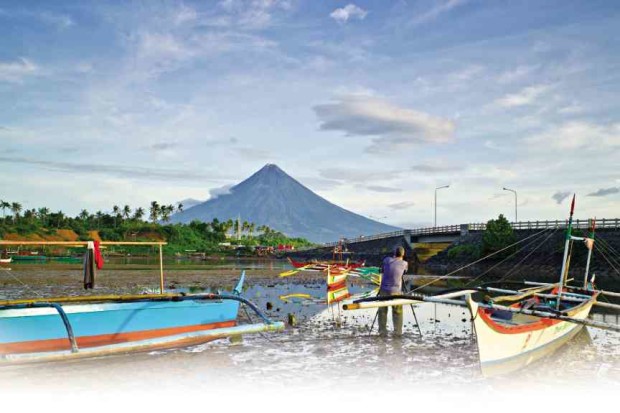
MAYON Volcano is a favorite subject of photographers but its restiveness has also brought hardships to communities near one of the country’s most active volcanoes. NOLI GABILO/CONTRIBUTOR
STO.DOMINGO, Albay—Water sources in communities in two Albay towns near Mt. Mayon have been drying up, a phenomenon which the Philippine Institute of Volcanology and Seismology (Phivolcs) attributed to the volcano’s restiveness.
Water in wells started receding in January, prompting the town council of Sto. Domingo last week to authorize Mayor Herbert Aguas to declare the town under a state of calamity as 17 of the town’s 23 villages started experiencing water shortage. More than 24,000 people live in these communities.
On Sept. 21, the local government of Malilipot declared a state of emergency in the town after 10 of 18 villages reported a decrease in water supply.
A Phivolcs official said the water supply situation might be linked to Mayon Volcano’s abnormal activity.
“It is not 100-percent conclusive, but because of the sulfur dioxide emission, there’s a possibility that this has a connection to the volcano,” said Ed Laguerta, Phivolcs resident volcanologist in Bicol.
Alert raised
Phivolcs raised Mt. Mayon’s alert level from zero to 1 on Sept. 8 after it showed signs of restiveness.
In an earlier interview, Alex Baloloy, Phivolcs science research specialist, said they noticed an increase in the number of earthquakes, sulfur dioxide emission, ground deformation and decrease in water discharge or drying up of water wells and streams around the volcano recently.
“Alert levels 1 and 2 serve to remind local governments to prepare their personnel for future evacuations and disaster response. Evacuations occur at alert levels 3 to 5,” Baloloy said.
He said no eruption is imminent when the alert level is raised to 1.
Water wells also ran dry in September 2014 when Mayon was under alert level 3.
Water discharge in four of 14 wells in the southeastern side of Mayon was decreasing while one well had dried up, Phivolcs said.
Laguerta said before Mayon erupted in 1993, “towns surrounding the volcano experienced water shortages.”
Bigger worry
He said the level of steam from the crater ranged from weak to moderate. However, no crater glow had been observed by Phivolcs.
Aguas, however, said they are worried about the water shortage.
“Imagine if the alert level is raised. We will be facing more problems. The last time Mayon’s alert level was raised to 3, the wells in Sto. Domingo dried up,” he said.
Aguas said when Phivolcs declared that volcanic activity has simmered down, “that was also the time that our water supply increased.”
“So we believe this is really because of Mayon,” he said.
Aguas said it did not rain in his town since July.
“I’m not asking for heavy rain, but we’re hoping that it rains because this can help [us] with the source of water,” he said.
New sources
The water district in Sto. Domingo identified a new source of potable water in Barangay Lidong that can supply 10 urban villages and three rural communities.
The local government is also planning to build a small impounding dam to collect water.
Malilipot has also identified a new water source in the town to supply six villages.
The Department of Social Welfare and Development sent more than 10,000 6-liter bottles of drinking water to Sto. Domingo. Truckloads of water for household use were also sent by the local governments of Tabaco City and Bacacay town, and the provincial government of Albay.
“When the new source of water is ready, we will be lifting the state of calamity [declaration],” Aguas said.